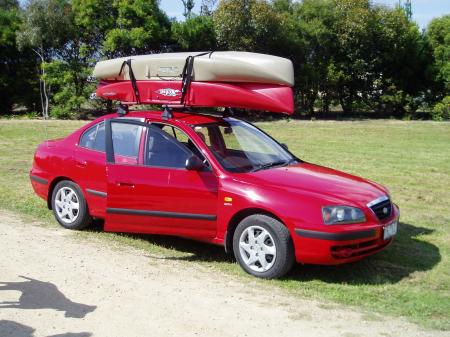Activity / How-To
How To Transport A Kayak

To enjoy a perfect day on the water, first you have to get there with an undamaged boat.
By: Jennifer McCutchen
With some of today’s lightweight kayaks, it may be tempting to try to transport them without any special equipment — don’t do it. To avoid serious damage to the boat, yourself and fellow drivers, invest in a durable rack system and appropriate tie-downs.
There are two types of rack systems that are designed to safely transport your kayak: foam saddles and roof-mounted rack systems. Foam saddle systems are easy to install, easy to remove, and can be found for under $50. These curved foam blocks sit between the kayak and the car’s roof. The entire system is secured in place by two or three sturdy straps that either attach to the car’s rain gutters or loop through the car’s open windows and attach inside.
The drawback to a foam rack is that it provides less security than a roof-mounted rack system. Your kayak could move around on top of your vehicle when you encounter wind or slam on your brakes. Even worse, your foam blocks might blow off from under your boat, causing the straps to loosen.
“Because of the kayak’s shape, it’s hard to find a foam rack that works well,” says Bob Spain, former director of coastal habitat resources for the Texas Parks and Wildlife Department. “You have to tie the kayak in the front and the back because there is nothing else to keep it secure.” If your vehicle came equipped with a factory rack, foam saddles that have precut grooves to slide over the load rack will provide more protection than those that are merely secured by straps. But foam saddle systems do offer an inexpensive alternative to a roof-mounted rack. These systems are ideal for those who transport their kayak only a few miles.
For more serious kayakers who travel greater distances to get to prime spots, a roof-mounted rack system is a much safer and more stable way to transport a kayak. With a roof rack specifically designed to transport kayaks, you can overcome the hazards that accompany a foam saddle system. “A real roof-mounted rack is more substantial, secure and simpler because it is actually bolted to your car,” says John Van Ness, owner of Austin Outdoor Gear & Guidance. Fortunately, roof-mounted rack systems can now adapt to almost any car, truck or SUV. Towers — small, sturdy, vertical supports that hold the rack on the car and keep the kayak from directly touching the roof — are either held in place by clamps or permanently fastened to the roof itself. The kayak is then supported on horizontal poles that lie between the towers. There are many different types, but most boats are secured to the bars by curved, cradle-like attachments. These padded braces gently clutch onto the sides of the kayak to keep it steady.
Most kayaks weigh between 35 and 90 pounds, so it is ideal for two people to help load and unload your kayak. “Having a friend grab one end of the kayak while you grab another is the easiest and most effective way to do it,” recommends Spain. Luckily, some manufacturers such as Yakama and Thule produce roof rack systems that come with accessories like rollers that help to simplify the process. With these, it’s possible for one person to place the front of the kayak on the rollers, pick up the back and roll it straight up onto the rack.
Once the kayak is loaded onto your vehicle, sturdy straps with spring-loaded buckles will do a much better job of keeping the kayak in place than simple rope. “They provide positive closure over a wider hull area and tend to reduce the damage on your kayak,” explains Spain. As a general rule, place some sort of cushioning between the buckle and the kayak. Doing so will lessen hull damage during transport. Tie off the extra strap directly above the buckle once it has been fastened tight, just in case the buckle releases while you’re driving. Additionally, Van Ness suggests tying “keeper” lines in the shape of an inverted V from both ends of the kayak to the car’s hood hinge for extra security. “If you open the hood and trunk and loop two pieces of rope, each 2 feet long, to the hinges and tie the bow lines to that, your kayak will be much more stable and will not slide forward if your car suddenly comes to a halt.”
Driving with a kayak atop a vehicle is not difficult, but it can be dangerous if the kayak is not properly loaded. No matter what sort of rack system and strategy you use to fasten a kayak to your car, Spain explains that it is essential that the craft not slide in any direction when the car is in motion; otherwise, you could lose your kayak. Buckles can unbuckle, knots can loosen and rope can stretch, so to be on the safe side, stop periodically to make sure that your kayak has not shifted during the trip.
———From the TPWD Magazine April 2005 Skillbuilder. If you’d like to read more articles like this or subscribe to the magazine, visit www.tpwmagazine.com.
 Texas Parks and Wildlife Department, 4200 Smith School Road, Austin, TX 78744
Texas Parks and Wildlife Department, 4200 Smith School Road, Austin, TX 78744


